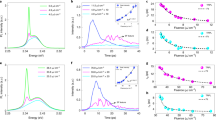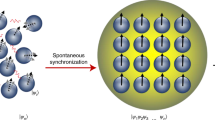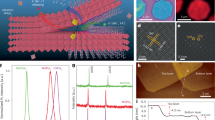Abstract
Fast thermal dephasing limits macroscopic quantum phenomena to cryogenic conditions1,2,3,4 and hinders their use at ambient temperatures5,6. For electronic excitations in condensed media, dephasing is mediated by thermal lattice motion1,7,8. Therefore, taming the lattice influence is essential for creating collective electronic quantum states at high temperatures. Although there are occasional reports of high-Tc quantum effects across different platforms, it is unclear which lattice characteristics and electron–lattice interactions lead to macroscopically coherent electronic states in solids9. Here we studied intensity fluctuations in the macroscopic polarization during the emergence of superfluorescence in a lead halide perovskite10 and showed that spontaneously synchronized polaronic lattice oscillations accompany collective electronic dipole emission. We further developed an effective field model and theoretically confirmed that exciton–lattice interactions lead to a new electronically and structurally entangled coherent extended solitonic state beyond a critical polaron density. The analysis shows a phase transition with two processes happening in tandem: incoherent disordered polaronic lattice deformations establish an order, while macroscopic quantum coherence among excitons simultaneously emerges. Recombination of excitons in this state culminates in superfluorescence at high temperatures. Our study establishes fundamental connections between the transient superfluorescence process observed after the impulsive excitation of perovskites and general equilibrium phase transitions achieved by thermal cooling. By identifying various electron–lattice interactions in the perovskite structure and their respective role in creating collectively coherent electronic effects in solids, our work provides unprecedented insight into the design and development of new materials that exhibit high-temperature macroscopic quantum phenomena.
This is a preview of subscription content, access via your institution
Access options
Access Nature and 54 other Nature Portfolio journals
Get Nature+, our best-value online-access subscription
$32.99 / 30 days
cancel any time
Subscribe to this journal
Receive 51 print issues and online access
$199.00 per year
only $3.90 per issue
Buy this article
- Purchase on SpringerLink
- Instant access to full article PDF
Prices may be subject to local taxes which are calculated during checkout





Similar content being viewed by others
Data availability
All data in the main text are provided with this paper. All other data supporting the plots in this paper are available from the corresponding author upon request. Source data are provided with this paper.
Code availability
The FHI-aims code, which was used for DFT-based calculations in this work, is a community-developed electronic structure code that can be obtained from https://fhi-aims.org. The licensing organization, MS1P e.V., is a non-profit organization focused on advancing basic science, based in Berlin, Germany. At the time of writing, co-author V.B. was the vice chair of MS1P e.V. Academic licenses for the FHI-aims code can be obtained for a voluntary license fee (that is, free of charge if requested) by any academic group. The code is distributed with full access to its source code, including all development repositories. The ELSI infrastructure software, referenced in the paper, is an open-source library to which FHI-aims links. ELSI can be obtained freely under the BSD3 open-source license at https://gitlab.com/elsi_project/elsi_interface.
References
Zurek, W. H., Habib, S. & Paz, J. P. Coherent states via decoherence. Phys. Rev. Lett. 70, 1187–1190 (1993).
Blach, D. D. et al. Superradiance and exciton delocalization in perovskite quantum dot superlattices. Nano Lett. 22, 7811–7818 (2022).
Sobirey, L. et al. Observation of superfluidity in a strongly correlated two-dimensional Fermi gas. Science 372, 844–846 (2021).
Pitaevskii, L. & Stringari, S. Thermal vs quantum decoherence in double well trapped Bose-Einstein condensates. Phys. Rev. Lett. 87, 180402 (2001).
Palma, G. M., Suominen, K.-a. & Ekert, A. Quantum computers and dissipation. Proc. R. Soc. Lond. A Math. Phys. Eng. Sci. 452, 567–584 (1996).
Reina, J. H., Quiroga, L. & Johnson, N. F. Decoherence of quantum registers. Phys. Rev. A 65, 032326 (2002).
Hackermüller, L., Hornberger, K., Brezger, B., Zeilinger, A. & Arndt, M. Decoherence of matter waves by thermal emission of radiation. Nature 427, 711–714 (2004).
Klembt, S., Stepanov, P., Klein, T., Minguzzi, A. & Richard, M. Thermal decoherence of a nonequilibrium polariton fluid. Phys. Rev. Lett. 120, 035301 (2018).
Zaanen, J. et al. Towards a complete theory of high Tc. Nat. Phys. 2, 138–143 (2006).
Biliroglu, M. et al. Room-temperature superfluorescence in hybrid perovskites and its origins. Nat. Photon. 16, 324–329 (2022).
Findik, G. et al. High-temperature superfluorescence in methyl ammonium lead iodide. Nat. Photon. 15, 676–680 (2021).
Rainò, G. et al. Superfluorescence from lead halide perovskite quantum dot superlattices. Nature 563, 671–675 (2018).
Nasu, M., Kawamura, K., Yoshida, T., Ishihara, J. & Miyajima, K. Influences of quantum fluctuation on superfluorescent spectra observed by single-shot measurement for semiconductor quantum dots. Appl. Phys. Express 13, 062005 (2020).
Haake, F., King, H., Schröder, G., Haus, J. & Glauber, R. Fluctuations in superfluorescence. Phys. Rev. A 20, 2047–2063 (1979).
Okada, J., Ikeda, K. & Matsuoka, M. Streak camera investigation of superradiance development. Opt. Commun. 27, 321–323 (1978).
Malcuit, M. S., Maki, J. J., Simkin, D. J. & Boyd, R. W. Transition from superfluorescence to amplified spontaneous emission. Phys. Rev. Lett. 59, 1189–1192 (1987).
Box, G. E. P., Jenkins, G. M., Reinsel, G. C. & Ljung, G. M. Time Series Analysis: Forecasting and Control (Wiley, 2015).
Miyata, K. et al. Large polarons in lead halide perovskites. Sci. Adv. 3, e1701217 (2017).
Nagai, M. et al. Longitudinal optical phonons modified by organic molecular cation motions in organic-inorganic hybrid perovskites. Phys. Rev. Lett. 121, 145506 (2018).
Guzelturk, B. et al. Terahertz emission from hybrid perovskites driven by ultrafast charge separation and strong electron–phonon coupling. Adv. Mater. 30, 1704737 (2018).
Cinquanta, E. et al. Ultrafast THz probe of photoinduced polarons in lead-halide perovskites. Phys. Rev. Lett. 122, 166601 (2019).
He, J., Vasenko, A. S., Long, R. & Prezhdo, O. V. Halide composition controls electron–hole recombination in cesium–lead halide perovskite quantum dots: a time domain ab initio study. J. Phys. Chem. Lett. 9, 1872–1879 (2018).
Boehme, S. C. et al. Phonon-mediated and weakly size-dependent electron and hole cooling in CsPbBr3 nanocrystals revealed by atomistic simulations and ultrafast spectroscopy. Nano Lett. 20, 1819–1829 (2020).
Masharin, M. A. et al. Polaron-enhanced polariton nonlinearity in lead halide perovskites. Nano Lett. 22, 9092–9099 (2022).
Masharin, M. A. et al. Room-temperature polaron-mediated polariton nonlinearity in MAPbBr3 perovskites. ACS Photon. 10, 691–698 (2023).
Menéndez‐Proupin, E., Beltrán Ríos, C. L. & Wahnón, P. Nonhydrogenic exciton spectrum in perovskite CH3NH3PbI3. Phys. Status Solidi Rapid Res. Lett. 9, 559–563 (2015).
Guzelturk, B. et al. Visualization of dynamic polaronic strain fields in hybrid lead halide perovskites. Nat. Mater. 20, 618–623 (2021).
Monahan, D. M. et al. Room-temperature coherent optical phonon in 2D electronic spectra of CH3NH3PbI3 perovskite as a possible cooling bottleneck. J. Phys. Chem. Lett. 8, 3211–3215 (2017).
Gogolin, A. O. & Ioselevich, A. S. Quantum polaron. Pisma Zh. Eksp. Teor. Fiz. 53, 456–460 (1991).
Gutfreund, H. & Weger, M. Temperature dependence of the metallic conductivity of tetrathiafulvalene-tetracyanoquinodimethane (TTF-TCNQ). Phys. Rev. B 16, 1753–1755 (1977).
Friedberg, R. & Lee, T. D. Fermion-field nontopological solitons. Phys. Rev. D 15, 1694–1711 (1977).
Friedberg, R., Lee, T. & Sirlin, A. Class of scalar-field soliton solutions in three space dimensions. Phys. Rev. D 13, 2739–2761 (1976).
Yazdani, N. et al. Coupling to octahedral tilts in halide perovskite nanocrystals induces phonon-mediated attractive interactions between excitons. Nat. Phys. 20, 47–53 (2024).
Blum, V. et al. Ab initio molecular simulations with numeric atom-centered orbitals. Comput. Phys. Commun. 180, 2175–2196 (2009).
Lejaeghere, K. et al. Reproducibility in density functional theory calculations of solids. Science 351, aad3000 (2016).
Mølmer, K., Castin, Y. & Dalibard, J. Monte Carlo wave-function method in quantum optics. J. Opt. Soc. Am. B 10, 524–538 (1993).
Acknowledgements
K.G., M.B. and M.T. acknowledge funding support from the Department of Energy, Office of Science under award no. DE-SC0024396 (optical spectroscopy and analytical theory development). K.G. and M.T. acknowledge discussions with M. Unsal. K.G. and M.B. acknowledge the NCSU Imaging and Kinetic Spectroscopy facility. V.V.T. acknowledges support from the CNRS Tremplin, Toptica Photonics, the Physics Department of École Polytechnique and Institut Polytechnique de Paris within the framework of a Projet de Recherche en Laboratoire, and R. Pretorian and T. Mocioi from the École Polytechnique for help with C++ programming of time-dependent parameters for Monte Carlo simulations. V.B., X.Q. and U.H. acknowledge funding support from the NSF award no. DMR-2323803, NSF award no. DMR-1729297 and NSF award no OAC-1450280 (DFT calculations). DFT calculations were carried out on resources of the National Energy Research Scientific Computing Center, a DOE Office of Science User Facility supported by the Office of Science of the US Department of Energy under contract no. DE-AC02-05CH11231 using NERSC award BES-ERCAP0024246.
Author information
Authors and Affiliations
Contributions
K.G. conceived the research problem and the proposed mechanism and supervised the studies. M.B. led the PL, TRPL and pump–probe characterization and analysis with the help of D.S., M.K. and M.A.; N.P. performed double-pulse TRPL experiments; M.T. developed the effective field theory. DFT simulations were performed by X.Q., and the Delta SCF method was implemented by U.H., both supervised by V.B. Monte Carlo simulations were performed by A.G. and V.V.T.; R.S., J.C. and F.S. provided the samples. K.G., M.B. and M.T. drafted the paper with the help of A.K.S., V.B. and V.V.T. All the authors edited the paper.
Corresponding author
Ethics declarations
Competing interests
The authors declare no competing interests.
Peer review
Peer review information
Nature thanks Giuseppe Luca Celardo, Ivan Shelykh and the other, anonymous, reviewer(s) for their contribution to the peer review of this work.
Additional information
Publisher’s note Springer Nature remains neutral with regard to jurisdictional claims in published maps and institutional affiliations.
Supplementary information
Rights and permissions
Springer Nature or its licensor (e.g. a society or other partner) holds exclusive rights to this article under a publishing agreement with the author(s) or other rightsholder(s); author self-archiving of the accepted manuscript version of this article is solely governed by the terms of such publishing agreement and applicable law.
About this article
Cite this article
Biliroglu, M., Türe, M., Ghita, A. et al. Unconventional solitonic high-temperature superfluorescence from perovskites. Nature 642, 71–77 (2025). https://doi.org/10.1038/s41586-025-09030-x
Received:
Accepted:
Published:
Issue date:
DOI: https://doi.org/10.1038/s41586-025-09030-x



